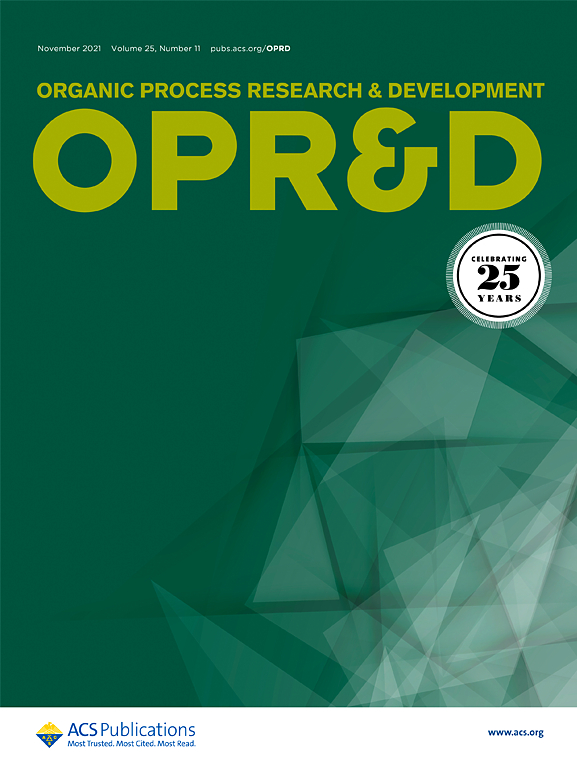Excellence in Industrial Organic Synthesis 2024
IF 3.1
3区 化学
Q2 CHEMISTRY, APPLIED
引用次数: 0
Abstract
Published as part of Organic Process Research & Development special issue “Excellence in Industrial Organic Synthesis 2024”. In the chemical industry, alongside the discovery of new substances and their properties, the development and optimization of chemical reactions and processes play a decisive role, not least for economic reasons. (1,2) This is nothing new. The interplay between research and development, and thus the pursuit of excellence in chemistry, has characterized the industry from the very beginning and will certainly continue to make a decisive contribution in the future, mastering the major challenges we are currently facing, from the demand for increased sustainability and efficient CO2 management to the changes in the supply of raw materials and energy. The conceptual foundations of excellence in chemistry can be traced back to the principle of parsimony by William of Ockham (1286–1347), a medieval Franciscan monk, and on his proverbial razor, in which he summed up the motivation of optimization in a single sentence: “It is futile to do with more what can be done with fewer” (Lat.: “Frustra fit per plura, quod potest fieri per pauciora”). (3,4) In accordance with this concept, James B. Hendrickson (1928–2018) outlined his ideas on the logic of organic chemistry and ideal synthesis already in 1975. (5,6) Barry Trost’s thoughts on atom economy followed in the early 1990s, while Paul A. Wender came up with function-oriented synthesis and step economy in 2008 (7) and Phil Baran and Reinhard Hoffmann with redox economy at almost the same time. (8) In parallel, Roger A. Sheldon emphasized the need for a new paradigm in the evaluation of efficiency in chemical production, assigning value not only to chemical yield but also to waste minimization. By developing the E-factor concept, which is now used throughout the industry in one form or another, he brought elegance and precision to large-scale production. (9−11) In this respect, it is perhaps not too surprising that some of these elegant processes have already been in operation for a while. As examples one may consider Evonik’s methionine production, BASF’s citral synthesis, and Rhodia’s vanillin process. (12) Taking James Hendrickson’s thoughts on the ideal synthesis as a starting point, this year we can indeed celebrate 50 years of excellence in industrial organic synthesis. Articles included in this Special Issue cover a wide variety of research topics such as discussion on strategies for kilogram-scale synthesis with emphasis on safety, robustness, and sustainability, flow and impinging-jet technologies, new catalytic methods, integration of Process Analytical Technologies (PAT) for solid-phase peptide synthesis, and green chemistry to name a few. These outstanding contributions provide an exquisite overview of the current state of the art and certainly pave the way for further improvements. Consistent with earlier issues in this series (2019 (13) and 2021 (14)), articles were received from both academic and industrial researchers, highlighting the value of collaboration between these groups to solve industry-relevant synthetic problems. We sincerely thank all the authors who have contributed to this Special Issue. Happy reading! This article references 14 other publications. This article has not yet been cited by other publications.卓越的工业有机合成2024
作为有机过程研究的一部分发表;发展特刊“工业有机合成卓越2024”。在化学工业中,除了发现新物质及其性质外,化学反应和工艺的开发和优化也起着决定性的作用,尤其是出于经济原因。这不是什么新鲜事。研究与开发之间的相互作用,以及对化学卓越的追求,从一开始就是该行业的特点,并且肯定会在未来继续做出决定性的贡献,掌握我们目前面临的主要挑战,从提高可持续性和有效的二氧化碳管理的需求到原材料和能源供应的变化。卓越化学的概念基础可以追溯到中世纪方济各会修士威廉·奥卡姆(William of Ockham, 1286-1347)提出的节俭原则,以及他那著名的剃刀,他在剃刀中用一句话总结了优化的动机:“用更少的东西可以做的事情,用更多的东西做是徒劳的”(Lat。(“挫败适合每plura, quod potest fieri per pauciora”)。(3,4)根据这一概念,James B. Hendrickson(1928-2018)早在1975年就提出了他关于有机化学逻辑和理想合成的思想。(5,6) Barry Trost的原子经济思想始于20世纪90年代初,Paul A. Wender于2008年提出了面向功能的合成和步骤经济(7),Phil Baran和Reinhard Hoffmann几乎同时提出了氧化还原经济。(8)与此同时,罗杰·a·谢尔登强调需要一种评价化学品生产效率的新范式,不仅要重视化学品产量,而且要重视尽量减少废物。通过开发E-factor概念,他为大规模生产带来了优雅和精确,该概念现在以各种形式在整个行业中使用。(9−11)在这方面,也许不太令人惊讶的是,这些优雅的过程中的一些已经运行了一段时间。例如,赢创的蛋氨酸生产、巴斯夫的柠檬醛合成和罗地亚的香兰素工艺。(12)以詹姆斯·亨德里克森关于理想合成的思想为出发点,今年我们确实可以庆祝工业有机合成取得卓越成就50周年。这期特刊的文章涵盖了广泛的研究主题,如讨论公斤级合成策略,重点是安全性,稳稳性和可持续性,流动和撞击射流技术,新的催化方法,固相肽合成过程分析技术(PAT)的集成,绿色化学等等。这些杰出的贡献提供了对当前艺术状态的精美概述,当然也为进一步改进铺平了道路。与本系列的早期问题(2019年(13)和2021年(14))一致,收到了来自学术和行业研究人员的文章,强调了这些群体之间合作解决与行业相关的综合问题的价值。我们衷心感谢所有为本期特刊做出贡献的作者。阅读的快乐!本文引用了其他14个出版物。这篇文章尚未被其他出版物引用。
本文章由计算机程序翻译,如有差异,请以英文原文为准。
求助全文
约1分钟内获得全文
求助全文
来源期刊
CiteScore
6.90
自引率
14.70%
发文量
251
审稿时长
2 months
期刊介绍:
The journal Organic Process Research & Development serves as a communication tool between industrial chemists and chemists working in universities and research institutes. As such, it reports original work from the broad field of industrial process chemistry but also presents academic results that are relevant, or potentially relevant, to industrial applications. Process chemistry is the science that enables the safe, environmentally benign and ultimately economical manufacturing of organic compounds that are required in larger amounts to help address the needs of society. Consequently, the Journal encompasses every aspect of organic chemistry, including all aspects of catalysis, synthetic methodology development and synthetic strategy exploration, but also includes aspects from analytical and solid-state chemistry and chemical engineering, such as work-up tools,process safety, or flow-chemistry. The goal of development and optimization of chemical reactions and processes is their transfer to a larger scale; original work describing such studies and the actual implementation on scale is highly relevant to the journal. However, studies on new developments from either industry, research institutes or academia that have not yet been demonstrated on scale, but where an industrial utility can be expected and where the study has addressed important prerequisites for a scale-up and has given confidence into the reliability and practicality of the chemistry, also serve the mission of OPR&D as a communication tool between the different contributors to the field.

 求助内容:
求助内容: 应助结果提醒方式:
应助结果提醒方式:


